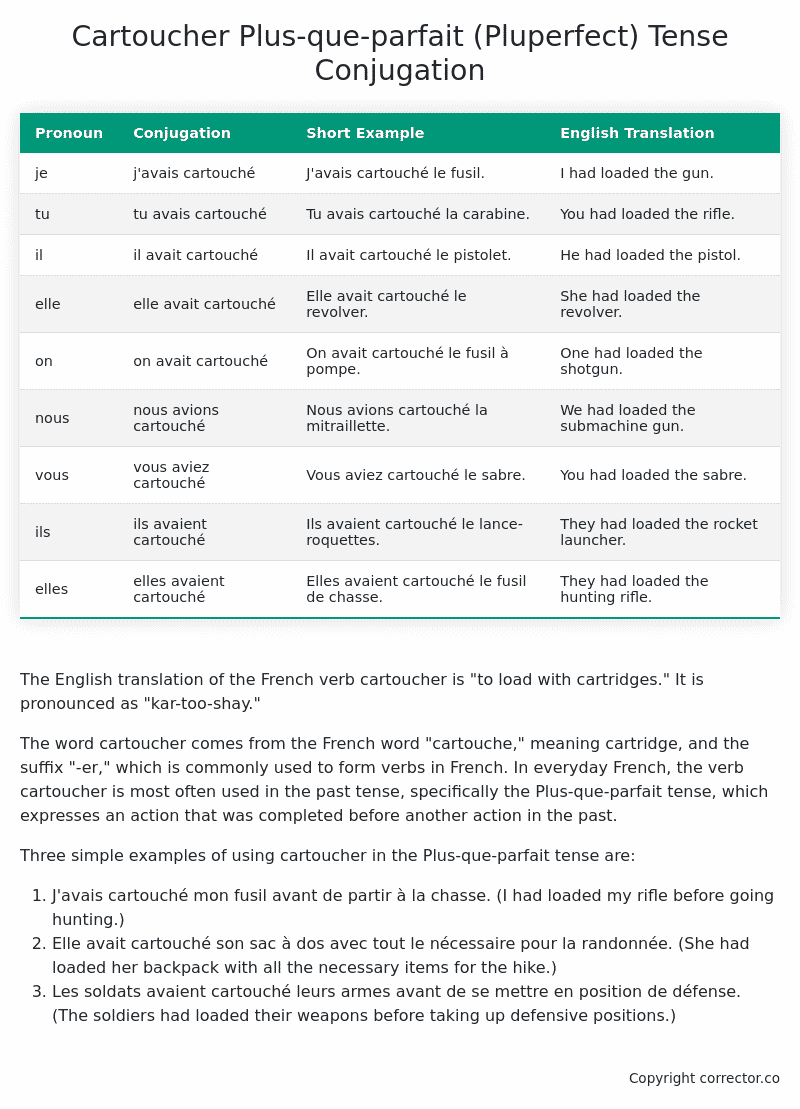Plus-que-parfait (Pluperfect) Tense Conjugation of the French Verb cartoucher
Introduction to the verb cartoucher
The English translation of the French verb cartoucher is “to load with cartridges.” It is pronounced as “kar-too-shay.”
The word cartoucher comes from the French word “cartouche,” meaning cartridge, and the suffix “-er,” which is commonly used to form verbs in French. In everyday French, the verb cartoucher is most often used in the past tense, specifically the Plus-que-parfait tense, which expresses an action that was completed before another action in the past.
Three simple examples of using cartoucher in the Plus-que-parfait tense are:
- J’avais cartouché mon fusil avant de partir à la chasse. (I had loaded my rifle before going hunting.)
- Elle avait cartouché son sac à dos avec tout le nécessaire pour la randonnée. (She had loaded her backpack with all the necessary items for the hike.)
- Les soldats avaient cartouché leurs armes avant de se mettre en position de défense. (The soldiers had loaded their weapons before taking up defensive positions.)
Table of the Plus-que-parfait (Pluperfect) Tense Conjugation of cartoucher
| Pronoun | Conjugation | Short Example | English Translation |
|---|---|---|---|
| je | j’avais cartouché | J’avais cartouché le fusil. | I had loaded the gun. |
| tu | tu avais cartouché | Tu avais cartouché la carabine. | You had loaded the rifle. |
| il | il avait cartouché | Il avait cartouché le pistolet. | He had loaded the pistol. |
| elle | elle avait cartouché | Elle avait cartouché le revolver. | She had loaded the revolver. |
| on | on avait cartouché | On avait cartouché le fusil à pompe. | One had loaded the shotgun. |
| nous | nous avions cartouché | Nous avions cartouché la mitraillette. | We had loaded the submachine gun. |
| vous | vous aviez cartouché | Vous aviez cartouché le sabre. | You had loaded the sabre. |
| ils | ils avaient cartouché | Ils avaient cartouché le lance-roquettes. | They had loaded the rocket launcher. |
| elles | elles avaient cartouché | Elles avaient cartouché le fusil de chasse. | They had loaded the hunting rifle. |
Other Conjugations for Cartoucher.
Le Present (Present Tense) Conjugation of the French Verb cartoucher
Imparfait (Imperfect) Tense Conjugation of the French Verb cartoucher
Passé Simple (Simple Past) Tense Conjugation of the French Verb cartoucher
Passé Composé (Present Perfect) Tense Conjugation of the French Verb cartoucher
Futur Simple (Simple Future) Tense Conjugation of the French Verb cartoucher
Futur Proche (Near Future) Tense Conjugation of the French Verb cartoucher
Plus-que-parfait (Pluperfect) Tense Conjugation of the French Verb cartoucher (this article)
Passé Antérieur (Past Anterior) Tense Conjugation of the French Verb cartoucher
Futur Antérieur (Future Anterior) Tense Conjugation of the French Verb cartoucher
Subjonctif Présent (Subjunctive Present) Tense Conjugation of the French Verb cartoucher
Subjonctif Passé (Subjunctive Past) Tense Conjugation of the French Verb cartoucher
Subjonctif Imparfait (Subjunctive Imperfect) Tense Conjugation of the French Verb cartoucher
Subjonctif Plus-que-parfait (Subjunctive Pluperfect) Tense Conjugation of the French Verb cartoucher
Conditionnel Présent (Conditional Present) Tense Conjugation of the French Verb cartoucher
Conditionnel Passé (Conditional Past) Tense Conjugation of the French Verb cartoucher
L’impératif Présent (Imperative Present) Tense Conjugation of the French Verb cartoucher
L’infinitif Présent (Infinitive Present) Tense Conjugation of the French Verb cartoucher
Struggling with French verbs or the language in general? Why not use our free French Grammar Checker – no registration required!
Get a FREE Download Study Sheet of this Conjugation 🔥
Simply right click the image below, click “save image” and get your free reference for the cartoucher Plus-que-parfait tense conjugation!

Cartoucher – About the French Plus-que-parfait (Pluperfect) Tense
Tense Formation
Common everyday usage patterns
Sequencing of past events
Background information
Hypothetical or reported speech
Interactions with other tenses
Summary
I hope you enjoyed this article on the verb cartoucher. Still in a learning mood? Check out another TOTALLY random French verb conjugation!


